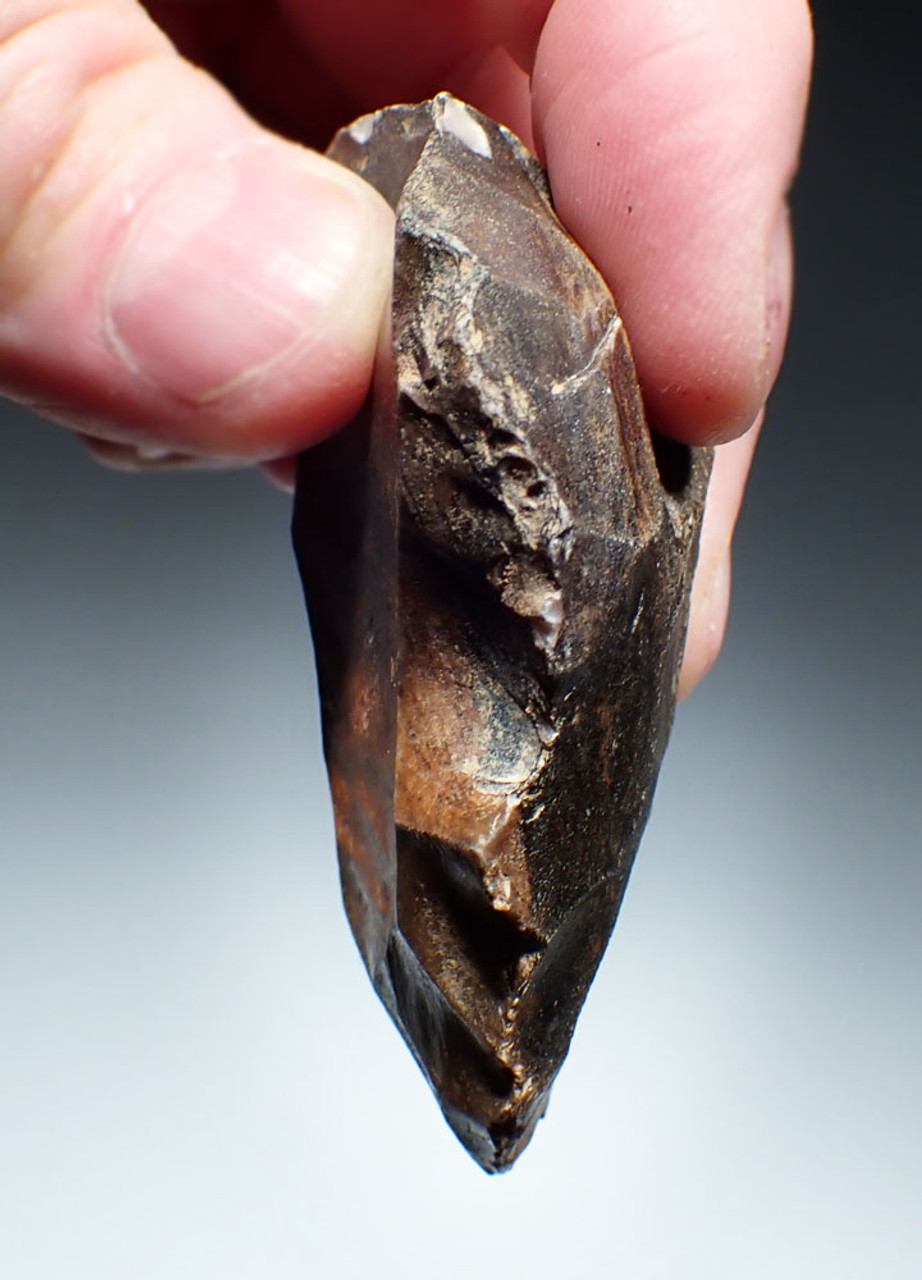Product Description
SEE MORE PREHISTORIC MIDDLE STONE AGE TOOLS
This incredibly rare African Middle Stone Age artifact is a TURTLEBACK BIFACE HAND AXE. It was found on an exposed Middle Paleolithic site in the Northwest Sahara Desert in association with several flake tools of the same period and make. It dates to the Middle Stone Age (MSA), between 280,000 and 50,000 years ago. Coming from our personal "BEST OF THE BEST" private collection that we had built over 22 years of extensive international travel, this was one of only THREE Middle Stone Age Africa hand axe bifaces, this being THE FINEST TURTLEBACK biface hand axe in our entire collection. Over the years, we had been setting aside the absolute finest examples of African Middle Stone Age tools that we acquired. Today, you just do not find specimens like this and we enjoyed the collection but now, it is now time to let someone else be their proud steward. This collection fills just one large Riker box display flat so once they are gone, these will be gone forever.
Made of tabular flint and flaked just like a turtle's shell with on flat, (actually, slightly concave!) underside with incredible radial perimeter flaking, and a bulbous protruding opposing opposing side, also wonderfully flaked with expert Levallois technique to create its beautiful dome shape. An ingenious finger grip feature was flaked into this amazing piece by its original prehistoric human flintknapper. The bulbous central part of the hand axe is rough and was the outer cortex layer of the original flint nodule this biface was made from. The knapper oriented to be in the center, and intelligently flaked recessed areas for the thumb and index finger, when held. Masterful radial flaking can be seen around the entire circumference of the side with surfaces leading up to create the turtleback feature. This feature was necessary in order to incorporate the recesses for the finger grip so, while it was an incredibly aesthetic attribute, it also had a purpose!
The typology and workmanship, along with the grip feature make this STUNNING Middle Stone Age hand axe worthy of publication! It is the ONLY turtleback Middle Stone Age biface hand axe we ever came across, and as previously stated, was one of only THREE Middle Stone Age North African bifaces in our entire collection. The supreme Levallois flaking throughout has been highlighted by mesmerizing 'desert varnish' patina gloss and coloration due to exposure - a smooth, glossy surface layer consisting of iron oxide and manganese deposited over thousands of years by exposure to blowing desert sand. Similar to the shrinking sizes of bifaces in the European Middle Paleolithic, this hand axe was likely made towards the end of the Middle Stone Age.
The Levallois technique is a name given by archaeologists to a distinctive type of stone knapping developed around 250,000 to 300,000 years ago during the Middle Paleolithic period. It is part of the Mousterian stone tool industry used by the Neanderthals in Europe, and by modern humans in other regions such as the Levant. In North Africa, the Levallois technique was used in the Middle Stone Age.
HISTORY
The Middle Stone Age (or MSA) was a period of African prehistory between the Early Stone Age and the Late Stone Age. It is generally considered to have begun around 280,000 years ago and ended around 50–25,000 years ago. The beginnings of particular MSA stone tools have their origins as far back as 550–500,000 years ago and as such some researchers consider this to be the beginnings of the MSA. The MSA is often mistakenly understood to be synonymous with the Middle Paleolithic of Europe, especially due to their roughly contemporaneous time span, however, the Middle Paleolithic of Europe represents an entirely different hominin population, Homo neanderthalensis, than the MSA of Africa, which did not have Neanderthal populations. Additionally, current archaeological research in Africa has yielded much evidence to suggest that modern human behavior and cognition was beginning to develop much earlier in Africa during the MSA than it was in Europe during the Middle Paleolithic. The MSA is associated with both anatomically modern humans (Homo sapiens) as well as archaic Homo sapiens.
The stone tool technology in use during the Middle Stone Age (MSA) shows a mosaic of techniques. Beginning approximately 300 kya, the large cutting tools of the Achuelian are gradually displaced by Levallois prepared core technologies, also widely used by Neanderthals during the European Middle Paleolithic. As the MSA progresses, highly varied technocomplexes become common throughout Africa and include pointed artifacts, blades, retouched flakes, end and side scrapers, grinding stones, and even bone tools. However, the use of blades (associated mainly with the Upper Paleolithic in Europe) is seen at many sites as well. In Africa, blades may have been used during the transition from the Early Stone Age to the Middle Stone Age onwards. Finally, during the later part of the Middle Stone Age, microlithic technologies aimed at producing replaceable components of composite hafted tools are seen from at least 70 ka at sites such as Pinnacle Point and Diepkloof Rock Shelter in South Africa.
 US DOLLAR
US DOLLAR
 EURO
EURO
 AUSTRALIAN DOLLAR
AUSTRALIAN DOLLAR
 CANADIAN DOLLAR
CANADIAN DOLLAR
 POUND STERLING
POUND STERLING
























